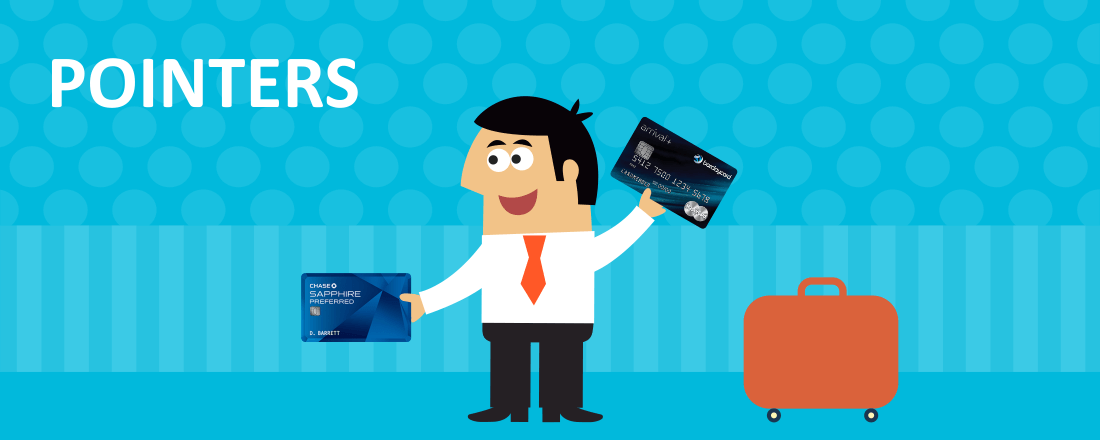
Travel Card Comparison: Chase Sapphire vs Barclaycard Arrival
As a frequent flyer, it makes sense to get a credit card to aid you in your travels. The primary reason is that loyalty is heavily rewarded in the hospitality industry. Oftentimes, you get a top or almost top status just by signing up for a credit card.
You may also get bonus points/miles for your initial spending on that card is defined as an amount of money that you have to charge using the card during a predetermined time period which is usually three months. Once you hit the amount of spending required, you then get the sign-up reward.
Here’s a comparisons of two very popular credit cards and their benefits; the Chase Sapphire card and the Barclay Arrival Plus card.
Sign-up Bonus Points
| Card Features | Sign-Up Bonus Points |
|---|---|
| Chase Sapphire | 50,000 after $4,000 spend in the first 90 days |
| Barclaycard Arrival+ | 40,000 after $3,000 spend in the first 90 days |
This is a major incentive when signing up for these cards. But it’s easy to forget. I was not paying attention to the spend and the time limit and ended up losing the bonus miles on a recent card I signed up for. Don’t let this happen to you. Typically you just need to use the cards for all purchases during this time period and keep track of how much you spent. In this case, the Chase Sapphire is the better deal, despite the additional $1,000 spend since the 50,000 points are more valuable.

Acquiring Points
| Card Features | Chase Sapphire | Barclaycard Arrival + |
|---|---|---|
| Travel Partner Redemptions | 2X | 2X |
| Travel Points | 2X | 2X |
| Other | 1X | 2X |
| Point Transfer | 1:1 Points can be transferred to airline programs | N/A Points cannot be transferred to airline programs |
Both programs are very close in terms of earning points. But the Chase Sapphire card takes the edge since you can transfer the points on a 1 to 1 ratio to airline programs. You can earn faster with Barclaycard Arrival + though since you get double points for everything, regardless of what you purchase. The Chase Sapphire card only earns double points for dining and travel so the arrival card has a bit of an edge over Sapphire on earning, unless most of your spending is eating out and traveling.

Points Redemption
| Card Features | Travel Partner Redemptions |
|---|---|
| Chase Sapphire | British Airways, Korean Air, Hyatt, IHG, Marriott, Priority Club, Ritz-Carlton, Singapore Airlines, United Airlines, Virgin Atlantic Airways |
| Barclaycard Arrival + | Avis, Budget, Hertz, Apple,Vacations, Carnival, Fairmont Hotels, Hyatt, Royal Caribbean, Sandals |
This is where the Chase Sapphire card runs away with the top prize. Currently, there are six airlines you can transfer to (all with international service) and the bonus alone can get you to Europe from the U.S. in economy class; one way at least. It can get you in business class on American, but you have to travel before March 22 when the rules changes.
Travel Insurance Features
| Card Features | Chase Sapphire | Barclaycard Arrival + |
|---|---|---|
| Trip Interruption Insurance | Yes | Yes |
| Travel Accident Insurance | Yes | Yes |
| Trip Cancellation Insurance | Yes | Yes |
| Baggage Delay Insurance | Yes | Yes |
| Auto Rental Collision Damage Waiver | Yes | Yes |
| Lost Luggage Reimbursement | Yes | No |
| Trip Delay Reimbursement | Yes | Yes |
| Purchase Protection | Yes | Yes |
| Extended Warranty Protection | Yes | Yes |
| Price Protection | Yes | Yes |
Travel insurance is a necessity for many when traveling as you never know when you’ll need it. Both cards have equally good protection with the Chase Sapphire card edging out the Barclaycard arrival + which does not provide protection for Lost Luggage reimbursement. The key here of course is to ensure that you use the cards to cover all of the travel purchase and ensure that the events for which you claim are covered. They both have a detailed benefits Guide which will show you what is covered.
Fees
| Card Features | Chase Sapphire | Barclaycard Arrival+ |
|---|---|---|
| Foreign Transaction Fee | None | None |
| Travel Redemption Discount | 20% | 5% miles back |
| Annual Fee | $95 waived for the first year | $89 waived for the first year |
| APR | 16.24% to 23.24% | 16.24% to 20.24% |
| Concierge Services | 24/7 service | MasterCard World Elite Concierge & Luxury Travel Benefits including 24/7 services |
Both cards are winners when it comes to foreign transaction fees. These fees can add up quickly as you pay usually about 3% of the transaction in fees. It is always better to use a credit card when you travel as this helps with the exchange rate as well and you pay no commission.
They both waive the annual fee for the first year and the $6 difference between the two is not significant at all.
The annual percentage rate is pretty much the same at the low end, but higher for the Chase Sapphire. But if you pay off your balances each month, then it doesn’t matter. And we recommend you do that or you negate the value of your rewards.
Having a concierge service is a key feature in travel, and both cards provide this services. This means you can call when you need something and there is someone to help you. Both cards excel here.
So having seen the features and benefits of both cards, which one is really right for your travels?
This will depend on what are your travels goals and here’s why:
If you are looking for travel partners such as airlines, hotels and car rental companies, then the Chase Sapphire card makes more sense since you can transfer one for one to several such programs. With Barclaycard, there are no airline partnerships so you are restricted to using it on existing flights at a penny per point value.
Are you a user of either card? What’s your take?
